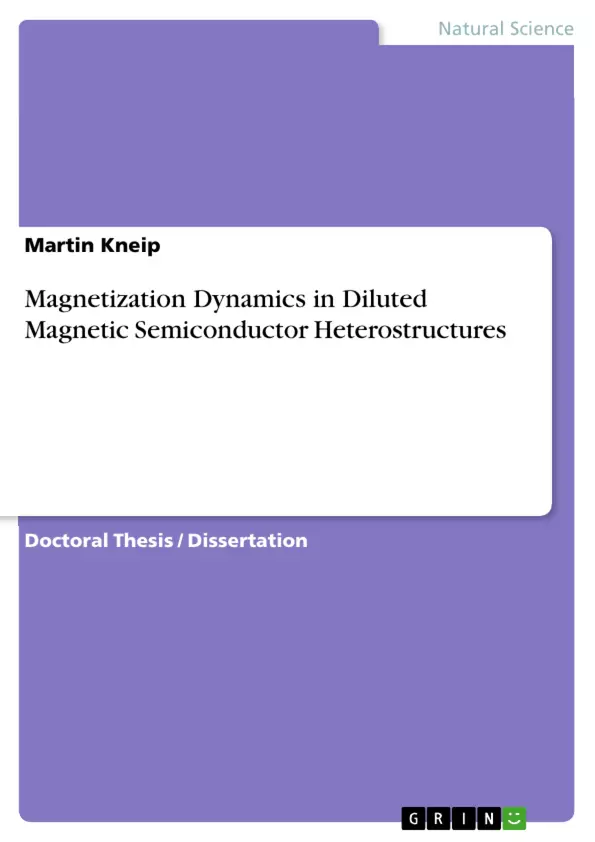In this thesis spin dynamics in (Zn,Mn)Se/(Zn,Be)Se and (Cd,Mn)Te/(Cd,Mg)Te DMS quantum well heterostructures with a type-I band alignment are studied, where the carriers are quantum confined. Especially the important role of free carriers in heating of the Mn-system, by its interaction with photoexcited carriers with excess kinetic energy, and in the cooling of the Mn-system in the presence of cold background carriers, provided by modulation doping, is established.
The studies are separated in three chapters. In the fourth chapter of this thesis, new results on energy and spin transfer between free carriers and Mn-ion system are presented. Contributions of direct heating of the Mn-system by photocarriers and indirect heating via nonequilibrium phonons are distinguished and their competition is discussed. In the fifth chapter dynamics of spin-lattice relaxation of magnetic Mn-ions in DMS QW heterostructures is investigated and new experimental studies on (Zn,Mn)Se/(Zn,Be)Se heterostructures are shown.
Crucial for spintronic devices is the ability to tune the spin relaxation time precisely, as the spin relaxation time is important in double respects. On the one hand spin polarization must be conserved over long times and distances, if the spin shall be processed or stored in a region, which is spatial separated from the spin-injector. Especially for the possibility of utilizing spins as quantum bits for quantum information processing, long spin polarization is needed. On the other hand short spin relaxation time is needed for fast switching between different spin-states. For instance semiconductor lasers can be switched off extremely fast by reorientation of spin. This very relevant topic is devoted the sixth chapter, before the thesis is summarized in the last chapter. Especially for one of the biggest drawbacks for precise tuning, that the magnetization dynamics in DMS cannot be controlled separately from the static magnetization, solutions via electric field control of the magnetization dynamics or via the technological concept of “digital alloying” are presented.precise tuning, that the magnetization dynamics in DMS cannot be controlled separately from the static magnetization, solutions via electric field control of the magnetization dynamics or via the technological concept of “digital alloying” are presented.
Inhaltsverzeichnis (Table of Contents)
- Introduction
- II-VI diluted magnetic semiconductors
- Crystal structure of (Cd,Mn)Te and (Zn, Mn)Se
- Band structure of (Cd,Mn)Te and (Zn, Mn)Se
- Band structure of zincblende semiconductors
- Band structure of zincblende semiconductors containing manganese
- Magnetic properties
- Basic principles of magnetism
- Larmor Diamagnetism
- Paramagnetism
- Heisenberg model
- Ferromagnetism
- Ferrimagnetism
- Antiferromagnetism
- Magnetic effects of free electrons
- Magnetic properties of (Cd,Mn)Te and (Zn, Mn)Se without Mn-Mn-interaction
- Exchange Interactions
- sp-d exchange interaction
- d-d exchange interaction
- Magnetic properties of (Cd,Mn)Te and (Zn, Mn)Se with Mn-Mn interactions
- Giant Zeeman-splitting
- Basic principles of magnetism
- Quantum well heterostructures
- Single-particle states in quantum wells
- Spin-orbit-splitting in quantum wells
- Heterostructures in magnetic field
- Density of states in quantum wells
- Selection rules and polarization degree in quantum wells
- Parabolic and half-parabolic quantum wells
- Excitons
- Free exciton
- Interaction of excitons with Mn²+-ions
- Quasi-two-dimensional excitons in quantum wells
- Quasi-two-dimensional excitons in magnetic field
- Trions
- Magnetization dynamics
- Spin and energy transfer
- Coupled systems in diluted magnetic semiconductors
- Theoretical formulation of spin and energy transfer
- Manganese spin temperature in stationary condition
- Mechanisms for spin relaxation
- Spin lattice relaxation
- Spin diffusion
- Spin and energy transfer
- Experimental technique
- Optical detection of Mn spin temperature
- Heating of the Mn spin system
- Time-resolved measurements
- Experimental setup
- Interaction between carriers and Mn-spin system
- Spin-lattice relaxation
- Control of spin-lattice relaxation
- Summary
Zielsetzung und Themenschwerpunkte (Objectives and Key Themes)
This dissertation investigates the magnetization dynamics in diluted magnetic semiconductor heterostructures. The work aims to understand the mechanisms governing spin and energy transfer between charge carriers and the Mn spin system, and to explore possibilities for controlling spin-lattice relaxation.
- Spin and energy transfer mechanisms in diluted magnetic semiconductors
- Spin relaxation mechanisms in these materials
- Control of spin-lattice relaxation through various techniques
- Characterisation of II-VI diluted magnetic semiconductors
- Experimental techniques for investigating magnetization dynamics
Zusammenfassung der Kapitel (Chapter Summaries)
The introduction provides background information on the subject. Chapter 1 details the properties of II-VI diluted magnetic semiconductors, including their crystal structure, band structure, and magnetic properties. Chapter 2 discusses magnetization dynamics, focusing on spin and energy transfer mechanisms and spin relaxation processes. Chapter 3 describes the experimental techniques used in the study. Chapter 4 analyzes the interaction between charge carriers and the Mn spin system. Chapters 5 and 6 explore spin-lattice relaxation and methods for its control.
Schlüsselwörter (Keywords)
Diluted magnetic semiconductors, magnetization dynamics, spin relaxation, spin-lattice relaxation, spin transfer, energy transfer, II-VI semiconductors, quantum well heterostructures, experimental techniques, Mn spin system.
- Arbeit zitieren
- Dr. rer.nat. Dipl.-Phys. Dipl.-Kfm. Martin Kneip (Autor:in), 2008, Magnetization Dynamics in Diluted Magnetic Semiconductor Heterostructures, München, GRIN Verlag, https://www.hausarbeiten.de/document/122287


